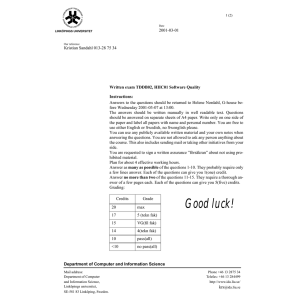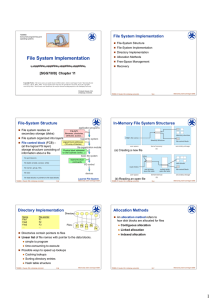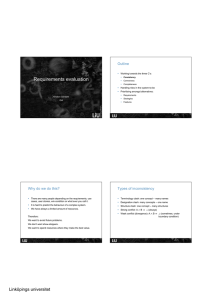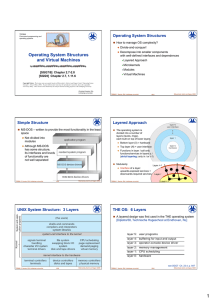Agenda Operating-System Structures
advertisement
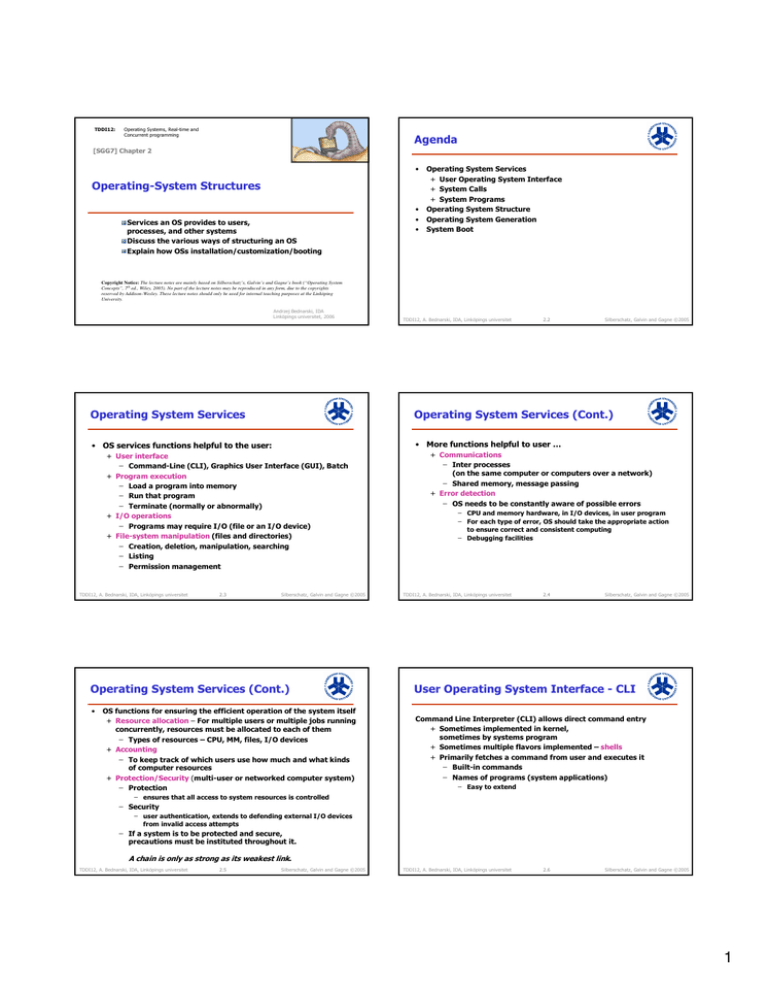
TDDI12: Operating Systems, Real-time and Concurrent programming Agenda [SGG7] Chapter 2 • Operating-System Structures Services an OS provides to users, processes, and other systems Discuss the various ways of structuring an OS Explain how OSs installation/customization/booting • • • Operating System Services + User Operating System Interface + System Calls + System Programs Operating System Structure Operating System Generation System Boot Copyright Notice: The lecture notes are mainly based on Silberschatz’s, Galvin’s and Gagne’s book (“Operating System Concepts”, 7th ed., Wiley, 2005). No part of the lecture notes may be reproduced in any form, due to the copyrights reserved by Addison-Wesley. These lecture notes should only be used for internal teaching purposes at the Linköping University. Andrzej Bednarski, IDA Linköpings universitet, 2006 TDDI12, A. Bednarski, IDA, Linköpings universitet 2.2 Silberschatz, Galvin and Gagne ©2005 Operating System Services Operating System Services (Cont.) • OS services functions helpful to the user: • More functions helpful to user … + User interface ̶ Command-Line (CLI), Graphics User Interface (GUI), Batch + Program execution ̶ Load a program into memory ̶ Run that program ̶ Terminate (normally or abnormally) + I/O operations ̶ Programs may require I/O (file or an I/O device) + File-system manipulation (files and directories) ̶ Creation, deletion, manipulation, searching ̶ Listing ̶ Permission management TDDI12, A. Bednarski, IDA, Linköpings universitet 2.3 Silberschatz, Galvin and Gagne ©2005 Operating System Services (Cont.) • OS functions for ensuring the efficient operation of the system itself + Resource allocation – For multiple users or multiple jobs running concurrently, resources must be allocated to each of them ̶ Types of resources – CPU, MM, files, I/O devices + Accounting ̶ To keep track of which users use how much and what kinds of computer resources + Protection/Security (multi-user or networked computer system) ̶ Protection ̶ ̶ TDDI12, A. Bednarski, IDA, Linköpings universitet 2.4 Silberschatz, Galvin and Gagne ©2005 User Operating System Interface - CLI Command Line Interpreter (CLI) allows direct command entry + Sometimes implemented in kernel, sometimes by systems program + Sometimes multiple flavors implemented – shells + Primarily fetches a command from user and executes it ̶ Built-in commands ̶ Names of programs (system applications) ̶ Easy to extend Security ̶ ̶ CPU and memory hardware, in I/O devices, in user program For each type of error, OS should take the appropriate action to ensure correct and consistent computing Debugging facilities ̶ ensures that all access to system resources is controlled ̶ ̶ + Communications ̶ Inter processes (on the same computer or computers over a network) ̶ Shared memory, message passing + Error detection ̶ OS needs to be constantly aware of possible errors user authentication, extends to defending external I/O devices from invalid access attempts If a system is to be protected and secure, precautions must be instituted throughout it. A chain is only as strong as its weakest link. TDDI12, A. Bednarski, IDA, Linköpings universitet 2.5 Silberschatz, Galvin and Gagne ©2005 TDDI12, A. Bednarski, IDA, Linköpings universitet 2.6 Silberschatz, Galvin and Gagne ©2005 1 User Operating System Interface - GUI • User-friendly desktop metaphor interface + Usually mouse, keyboard, and monitor + Icons represent files, programs, actions, etc. + Various mouse buttons over objects in the interface cause various actions (provide information, options, execute function, open directory (known as a folder) + Invented at Xerox PARC • Many systems now include both CLI and GUI interfaces + Microsoft Windows is GUI with CLI “command” shell + Apple Mac OS X as “Aqua” GUI interface with UNIX kernel underneath and shells available + Solaris is CLI with optional GUI interfaces (Java Desktop, KDE) TDDI12, A. Bednarski, IDA, Linköpings universitet 2.7 Silberschatz, Galvin and Gagne ©2005 Dual-Mode Operation • System Calls • • • • Mechanism API Passing parameters Types of system calls TDDI12, A. Bednarski, IDA, Linköpings universitet Sharing system resources requires the operating system to ensure that an incorrect program cannot cause other programs to execute incorrectly. • Provide hardware support to differentiate between at least two modes of operations. + User mode execution done on behalf of a user. + Monitor mode (also supervisor mode or system mode) execution done on behalf of operating system. Executes only privileged instructions (instructions that may be harmful: e.g., system login, set priorities, system halt, etc.) 2.9 Silberschatz, Galvin and Gagne ©2005 System Calls • • • • monitor user set user mode Privileged instructions can be issued only in monitor mode. TDDI12, A. Bednarski, IDA, Linköpings universitet 2.10 Silberschatz, Galvin and Gagne ©2005 Example of System Calls Programming interface to the services provided by the OS Typically written in a high-level language (C or C++) Mostly accessed by programs via a high-level Application Program Interface (API) rather than direct system call Three most common APIs + Win32 API for Windows + POSIX API for POSIX-based systems (including virtually all versions of UNIX, Linux, and Mac OS X) + Java API for the Java virtual machine (JVM) TDDI12, A. Bednarski, IDA, Linköpings universitet Mode bit added to computer hardware to indicate the current mode: monitor (0) or user (1). When an interrupt or fault occurs hardware switches to monitor mode. interrupt/fault • TDDI12, A. Bednarski, IDA, Linköpings universitet Silberschatz, Galvin and Gagne ©2005 Dual-Mode Operation (Cont.) • • 2.8 2.11 Silberschatz, Galvin and Gagne ©2005 • System call sequence to copy the contents of one file to another file TDDI12, A. Bednarski, IDA, Linköpings universitet 2.12 Silberschatz, Galvin and Gagne ©2005 2 Example of Standard API • • System Call Implementation Consider the ReadFile() function in the Win32 API—a function for reading from a file • • • • A description of the parameters passed to ReadFile() + HANDLE file—the file to be read + LPVOID buffer—a buffer where the data will be read into and written from + DWORD bytesToRead—the number of bytes to be read into the buffer + LPDWORD bytesRead—the number of bytes read during the last read + LPOVERLAPPED ovl—indicates if overlapped TDDI12, A. Bednarski, IDA, Linköpings universitet 2.13 Silberschatz, Galvin and Gagne ©2005 API – System Call – OS Relationship Typically, a number associated with each system call + System-call interface maintains a table indexed according to these numbers The system call interface invokes intended system call in OS kernel and returns status of the system call and any return values The caller need know nothing about how the system call is implemented + Just needs to obey API and understand what OS will do as a result call + Most details of OS interface hidden from programmer by API ̶ Managed by run-time support library (set of functions built into libraries included with compiler) TDDI12, A. Bednarski, IDA, Linköpings universitet 2.14 Silberschatz, Galvin and Gagne ©2005 Standard C Library Example C program invoking printf() library call, which calls write() system call 0; TDDI12, A. Bednarski, IDA, Linköpings universitet 2.15 Silberschatz, Galvin and Gagne ©2005 System Call Parameter Passing • • TDDI12, A. Bednarski, IDA, Linköpings universitet 2.16 Silberschatz, Galvin and Gagne ©2005 Parameter Passing via Table Often, more information is required than simply identity of desired system call + Exact type and amount of information vary according to OS and call Three general methods used to pass parameters to the OS + Simplest: pass the parameters in registers ̶ In some cases, may be more parameters than registers + Parameters stored in a block, or table, in memory, and address of block passed as a parameter in a register ̶ This approach taken by Linux and Solaris + Parameters placed, or pushed, onto the stack by the program and popped off the stack by the operating system Block and stack methods do not limit the number or length of parameters being passed. TDDI12, A. Bednarski, IDA, Linköpings universitet 2.17 Silberschatz, Galvin and Gagne ©2005 TDDI12, A. Bednarski, IDA, Linköpings universitet 2.18 Silberschatz, Galvin and Gagne ©2005 3 Types of System Calls • • • • • MS-DOS execution Process control + Load, execute, end, abort, terminate, wait … memory allocation and deallocation File management + Open, close, create, delete, read, write, get/set attributes Device management + Request, release, read, write, … Information maintenance + Get/set time, date, system data, process/file attributes Communications + Create/delete connection, send, receive, … (a) At system startup (b) Running a program TDDI12, A. Bednarski, IDA, Linköpings universitet 2.19 Silberschatz, Galvin and Gagne ©2005 FreeBSD Running Multiple Programs TDDI12, A. Bednarski, IDA, Linköpings universitet 2.21 Silberschatz, Galvin and Gagne ©2005 Solaris 10 dtrace Following System Call • Provide a convenient environment for program development and execution. + File manipulation + Status information + File modification + Programming language support + Program loading and execution + Communications + Application program • Some of them are simply user interfaces to system calls; others are considerably more complex Most users’ view of the operation system is defined by system programs, not the actual system calls TDDI12, A. Bednarski, IDA, Linköpings universitet • • • • 2.23 Silberschatz, Galvin and Gagne ©2005 2.22 Silberschatz, Galvin and Gagne ©2005 Operating System Design and Implementation • TDDI12, A. Bednarski, IDA, Linköpings universitet Silberschatz, Galvin and Gagne ©2005 System Programs • TDDI12, A. Bednarski, IDA, Linköpings universitet 2.20 Design and Implementation of OS not “solvable”, but some approaches have proven successful Internal structure of different Operating Systems can vary widely Start by defining goals and specifications Affected by choice of hardware, type of system User goals and System goals + User goals Operating system should be convenient to use, easy to learn, reliable, safe, and fast + System goals Operating system should be easy to design, implement, and maintain, as well as flexible, reliable, error-free, and efficient TDDI12, A. Bednarski, IDA, Linköpings universitet 2.26 Silberschatz, Galvin and Gagne ©2005 4 Operating System Design and Implementation (Cont.) • • Important principle to separate Policy: What will be done? Mechanism: How to do it? Mechanisms determine how to do something, policies decide what will be done + The separation of policy from mechanism is a very important principle, it allows maximum flexibility if policy decisions are to be changed later Simple Structure • MS-DOS – written to provide the most functionality in the least space + Not divided into modules + Although MS-DOS has some structure, its interfaces and levels of functionality are not well separated MS-DOS Structure TDDI12, A. Bednarski, IDA, Linköpings universitet 2.27 Silberschatz, Galvin and Gagne ©2005 Layered Approach • The operating system is divided into a number of layers (levels), each built on top of lower layers. The bottom layer (layer 0), is the hardware; the highest (layer N) is the user interface. • With modularity, layers are selected such that each uses functions (operations) and services of only lower-level layers TDDI12, A. Bednarski, IDA, Linköpings universitet TDDI12, A. Bednarski, IDA, Linköpings universitet Silberschatz, Galvin and Gagne ©2005 UNIX • 2.29 Silberschatz, Galvin and Gagne ©2005 UNIX System Structure 2.30 Silberschatz, Galvin and Gagne ©2005 Microkernel System Structure • • 2.31 UNIX – limited by hardware functionality, the original UNIX operating system had limited structuring. The UNIX OS consists of two separable parts + Systems programs + The kernel ̶ Consists of everything below the system-call interface and above the physical hardware ̶ Provides the file system, CPU scheduling, memory management, and other operating-system functions; a large number of functions for one level TDDI12, A. Bednarski, IDA, Linköpings universitet • • TDDI12, A. Bednarski, IDA, Linköpings universitet 2.28 Silberschatz, Galvin and Gagne ©2005 Moves as much from the kernel into “user” space Communication takes place between user modules using message passing Benefits: + Easier to extend a microkernel + Easier to port the operating system to new architectures + More reliable (less code is running in kernel mode) + More secure Detriments: + Performance overhead of user space to kernel space communication TDDI12, A. Bednarski, IDA, Linköpings universitet 2.32 Silberschatz, Galvin and Gagne ©2005 5 Modules • • Virtual Machines Most modern operating systems implement kernel modules + Uses object-oriented approach + Each core component is separate + Each talks to the others over known interfaces + Each is loadable as needed within the kernel Overall, similar to layers but with more flexible • A virtual machine takes the layered approach to its logical conclusion. It treats hardware and the operating system kernel as though they were all hardware • A virtual machine provides an interface identical to the underlying bare hardware • The operating system creates the illusion of multiple processes, each executing on its own processor with its own (virtual) memory Solaris modular approach TDDI12, A. Bednarski, IDA, Linköpings universitet 2.34 Silberschatz, Galvin and Gagne ©2005 Virtual Machines (Cont.) • TDDI12, A. Bednarski, IDA, Linköpings universitet 2.35 Silberschatz, Galvin and Gagne ©2005 Virtual Machines (Cont.) The resources of the physical computer are shared to create the virtual machines + CPU scheduling can create the appearance that users have their own processor + Spooling and a file system can provide virtual card readers and virtual line printers + A normal user time-sharing terminal serves as the virtual machine operator’s console (a) native machine (b) virtual machine TDDI12, A. Bednarski, IDA, Linköpings universitet 2.36 Silberschatz, Galvin and Gagne ©2005 Virtual Machines (Cont.) The virtual-machine concept provides complete protection of system resources since each virtual machine is isolated from all other virtual machines. This isolation, however, permits no direct sharing of resources. • A virtual-machine system is a perfect vehicle for operatingsystems research and development. System development is done on the virtual machine, instead of on a physical machine and so does not disrupt normal system operation. • The virtual machine concept is difficult to implement due to the effort required to provide an exact duplicate to the underlying machine 2.38 2.37 Silberschatz, Galvin and Gagne ©2005 2.39 Silberschatz, Galvin and Gagne ©2005 VMware Architecture • TDDI12, A. Bednarski, IDA, Linköpings universitet TDDI12, A. Bednarski, IDA, Linköpings universitet Silberschatz, Galvin and Gagne ©2005 TDDI12, A. Bednarski, IDA, Linköpings universitet 6 The Java Virtual Machine TDDI12, A. Bednarski, IDA, Linköpings universitet 2.40 Operating System Generation Silberschatz, Galvin and Gagne ©2005 System Boot • Operating systems are designed to run on any of a class of machines + the system must be configured for each specific computer site • SYSGEN: program obtains information concerning the specific configuration of the hardware system • Booting Starting a computer by loading the kernel • Bootstrap program Code stored in ROM that is able to locate the kernel, load it into memory, and start its execution. TDDI12, A. Bednarski, IDA, Linköpings universitet 2.41 Silberschatz, Galvin and Gagne ©2005 Recommended Reading and Exercises Operating system must be made available to hardware so hardware can start it + When power initialized on system, execution starts at a fixed memory location ̶ Firmware used to hold initial boot code + Bootstrap loader Small piece of code locates the kernel, loads it into memory, and starts it + Two-step process Boot block at fixed location loads bootstrap loader TDDI12, A. Bednarski, IDA, Linköpings universitet • 2.42 Silberschatz, Galvin and Gagne ©2005 • Reading + [SGG7] Chapter 2 • Exercises + All • Project + Adding a system call to the Linux kernel TDDI12, A. Bednarski, IDA, Linköpings universitet 2.43 Silberschatz, Galvin and Gagne ©2005 7
